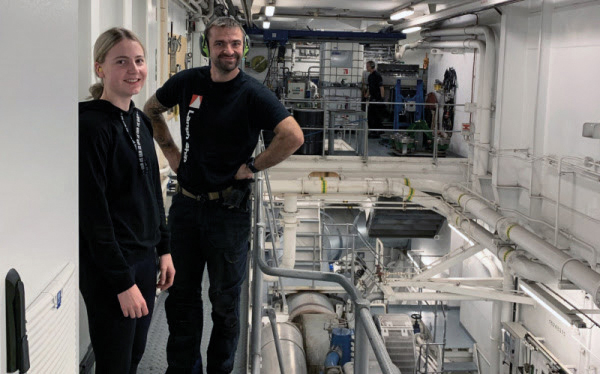
Scrubbing SOx plus CO2
Sea trials indicate existing scrubbers can be modified to also capture significant amounts of CO2 during normal operation
Scrubber manufacturer Langh Tech has started researching the possibility of carbon capture on board vessels. It says initial tests have been successfully performed on board one of the vessels in sister company Langh Ship’s fleet, utilising the existing Langh Tech hybrid scrubber installed on board.
February 15, 2022
Langh Tech says it has conducted several preliminary tests of capturing CO2 emitted by a vessel’s main engine by the means of using an existing Langh Tech closed loop SOx scrubber system. In the tests, additional alkali was added to the scrubber closed loop process water in order to provoke a reaction between the alkali and CO2, effectively capturing the CO2 from the exhaust gas into the process water. The setup of tests was limited by the capacity of the existing alkali pump, but positive results were observed even with only a slight increase in the alkali dosing. At a main engine load of approximately 85%, a 5% increase in alkali dosing (over normal level) was able to reduce the measured CO2 emission by 3,3%. At 40% main engine load, a CO2 emission reduction of nearly 7% was observed.
During the tests, the alkali consumption remained at a reasonable level, and the impact on the operating expenses of the vessel would be acceptable. According to Langh Tech the results of the tests are tentative proof of concept and additional tests with further increased alkali feed will be conducted to verify this. It adds that the CO2 capture feature could be applied to any Langh Tech closed loop or hybrid scrubber systems with relatively low cost impact, with only minor changes to the existing scrubber system. The process could be performed with readily available alkali products such as NaOH and MgOH2, which are both already being used in many SOx scrubber processes.
Langh Tech is also researching methods of extracting the captured CO2 from the process water and looking for ways to store and/or utilize the captured CO2 efficiently both onboard vessels and upon possible discharge to shore.
New CO2 separation membrane
In a development that could be applied in the shipping industry in the longer term, Japan-based NGK Insulators has developed a CO2 separation membrane for industrial exhaust gas. In testing with simulated industrial exhaust gas, the membrane achieved a CO2 separation factor approximately five times that of conventionally developed DDR-type zeolite membrane used for CO2 separation.
The company aims to continue with development for further increases in separation performance, aiming for commercialisation in 2030 after demonstration testing.
The company has been successful in developing a DDR-type zeolite membrane, which is one of the world’s largest ceramic CO2 separation membranes. Demonstration testing of these membranes is currently in progress.
The conventionally developed DDR-type zeolite membrane can be used for CO2 separation using differences in molecule size. It is easily able to separate CO2 in associated gas and natural gas, since methane, their major component, has a larger molecule size than CO2.
On the other hand, in industrial exhaust gas, the major components are nitrogen and oxygen, which have molecule sizes similar to CO2. Therefore, it is difficult to precisely separate CO2 from industrial exhaust gas using a DDR-type zeolite membrane.
The newly developed CO2 separation membrane for industrial exhaust gas makes use of a difference in adsorption characteristics (affinity) for molecules to separate CO2 from nitrogen and oxygen, which increases the CO2 separation factor. In testing using simulated industrial exhaust gas, the new membrane was confirmed to have approximately five times the CO2 separation factor of a conventionally developed DDR-type zeolite membrane.
Using the characteristics of ceramics, which can be used under harsh conditions, the company says it is working to increase the separation factor even further for high temperature industrial exhaust gases.
Get in touch
Contact one of the World Bunkering team.
Constructive Media
Constructive Media
50 George Street,
Pontypool
NP4 6BY
Tel: 01495 740050
Email: ibia@constructivemedia.co.uk
On behalf of :
IBIA Ltd
Office 239
New Broad Street House
35 New Broad Street
London,
EC2M 1NH
United Kingdom
Tel: +44 (0) 20 3397 3850
Fax: +44 (0) 20 3397 3865
Email: ibia@ibia.net
Website: www.ibia.net
Emails
Publisher & Designer: Constructive Media - ibia@constructivemedia.co.uk
Editor: David Hughes - anderimar.news@googlemail.com
Deputy Editor: Unni Einemo - unni@ibia.net
Project Manager: Alex Corboude - alex@worldbunkering.net
Terms & Conditions | Copyright © 2021 World Bunkering
